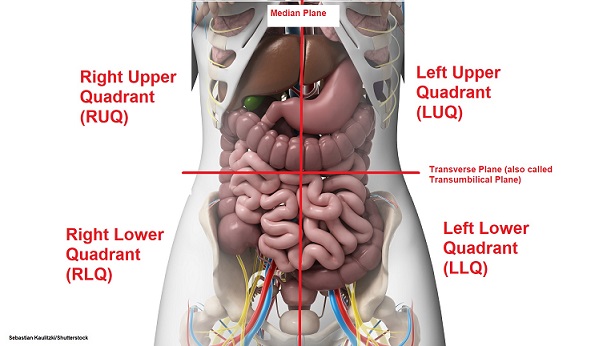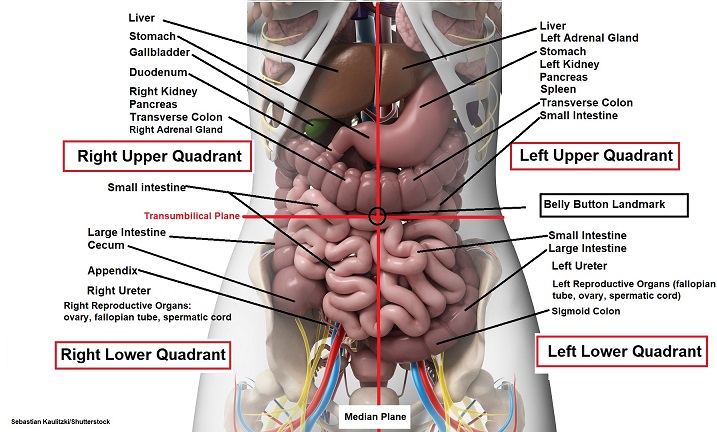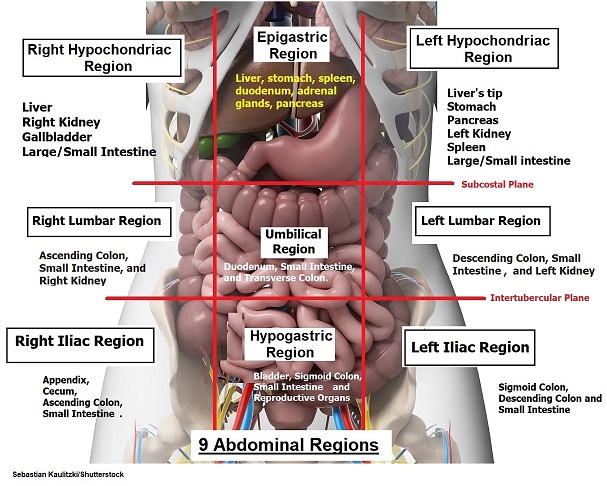In anatomy and physiology, you’ll learn how to divide the abdomen into nine different regions and four different quadrants. If you plan to enter a healthcare profession such as nursing, this is something you’ll use on the job when performing abdominal assessments (and while documenting).
The Four Abdominal Quadrants
First, let’s take a look at the four quadrants, which are created by an intersecting horizontal (transverse) plane, also called the transumbilical plane, and a median (midsagittal) plane.
The four quadrants are easy to remember because they consist of a left upper quadrant (LUQ), left lower quadrant (LLQ), right upper quadrant (RUQ), and right lower quadrant (RLQ).

Here are two important things to remember with these four quadrants:
-
- The navel (belly button) is the landmark you’ll use to visualize these quadrants while doing assessments. This is the point at which the two planes cross.
- The terms “left/right” and “upper/lower” are always from the perspective of the anatomical position, not your perspective. Be careful not to mix up your right and left regions, as this is where most students make a mistake!
Major Organs in the Four Quadrants
Here are some of the major organs that you’ll find in each of the four abdominal quadrants:

- Right Upper Quadrant: Liver, stomach, gallbladder, duodenum, right kidney, pancreas, and the right adrenal gland.
- Left Upper Quadrant: Liver, stomach, pancreas, left kidney, spleen, and the left adrenal gland.
- Right Lower Quadrant: appendix, reproductive organs, right ureter.
- Left Lower Quadrant: left ureter, reproductive organs
- NOTE: All four quadrants contain portions of the small and large intestines.
The Nine Abdominal Regions
The nine abdominal regions divide the abdomen into even smaller sections by using two parasagittal planes that run down the middle of the clavicle bones (also called midclavicular planes) and two horizontal (transverse) planes.
The superior transverse plane is called the subcostal plane, and it is located just below the ribs. The intertubercular plane is the inferior transverse plane, and it intersects the tubercles of the pelvis, running just inferior to the navel.
It’s important for you to know the names and locations of these nine regions, so here are some tips for remembering them:

First, let’s cover the right and left columns, because they have the same exact name (distinguished by a left or right prefix), and they are named after the bones to which they are nearest. Remember, a huge tip for studying anatomy is to learn common prefixes and suffixes, as they will help you over and over again!
- Hypochondriac Regions (Left and Right): the prefix “hypo” means below or under. The word “chondriac” means cartilage, which is referring to the cartilage of the ribs. When we put them together, this is the abdominal region that is under the ribs. Boom. Easy. So you have a right and left hypochondriac region.
- Lumbar Regions (Left and Right): The word lumbar refers to the vertebrae in your lower back, which are the bones nearest to the lumbar region. That’s where this region gets its name.
- Iliac Region (Left and Right): The top of the hip bone has what is called the iliac crest, and that’s the bone closest to the iliac region.
That takes care of the left and right columns. Now let’s look at the abdominal regions in the middle column. Unlike the regions on the left and right side columns, these regions are named after their location relative to the stomach, not the bones.
- Epigastric Region: The prefix “epi” means above, or over, and “gastric” means stomach or belly. Therefore, this is the region over and above the belly.
- Umbilical Region: This is easy to remember because the umbilical region contains your navel, which is also called the umbilicus. The navel is the landmark for the four quadrant point of intersection, and it can also help you remember that the umbilical region makes up the middle of the nine abdominal regions.
- Hypogastric Region: We’ve already learned that hypo means “below,” and gastric refers to the stomach or belly. So when we put the two together, we know that the hypogastric region is the region below the belly.
If you need a quick memory trick to keep these regions straight, remember that for the side columns, the names are the same from top to bottom: Hypochondriac, then Lumbar, and then Iliac (HLI). For the middle column, the regions are Epigastric, then Umbilical, and then Hypogastric (EUH). Remember this phrase: Hector Loves Isabel Every Unceasing Hour.
Organs in the Nine Abdominal Regions
Now let’s take a look at some of the major organs that you’ll find in each region. In most basic anatomy courses, professors probably don’t expect you to memorize a list of the organs you’ll find in each region, but try to get a general understanding of where the organs are located.

- Right Hypochondriac Region: You’ll find organs such as the liver, gallbladder, right kidney, and portions of the small and large intestine in this region.
- Epigastric Region: This region contains portions of the liver, as well as the stomach, pancreas, duodenum, spleen, and adrenal glands.
- Left Hypochondriac Region: This contains the spleen, large/small intestines, left kidney, pancreas, stomach, and tip of the liver.
- Right Lumbar Region: You’ll find portions of the ascending colon, small intestine, and right kidney in this region.
- Umbilical Region: Here you’ll find the duodenum, the small intestine, as well as the transverse colon.
- Left Lumbar Region: You’ll find parts of the descending colon, small intestine, and left kidney in this region.
- Right Iliac Region: Here you’ll find the appendix, cecum, ascending colon, and small intestine.
- Hypogastric Region: You’ll find the bladder, portions of the sigmoid colon, small intestine, and reproductive organs in this region.
- Left Iliac Region: You’ll find parts of the sigmoid colon, descending colon and small intestine in this region.
Ready to test your knowledge? Take our free (and quick!) abdominal regions and quadrants quiz. Also, you might want to watch more of our anatomy and physiology lectures on YouTube, or check our anatomy and physiology notes.